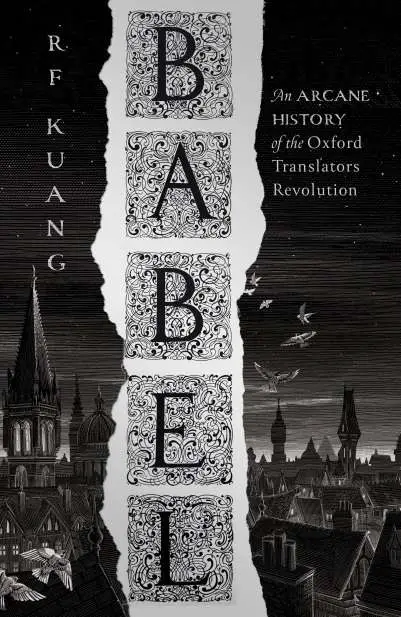In the Old Testament, the tale of the Tower of Babel is only nine short verses long. More an aside than a fully developed story, it’s essentially one of those folkloric explanations for how and why something in the world—in this case, different languages and peoples—came to be. And yet there’s something about that simple premise and scanty detail that seems to fire up the imagination of SFF writers.
In the last twelve months, I’ve read three very different stories inspired by the Babel myth: Tower of Babylon, a short story by Ted Chiang in his collection Stories of Your Life and Others; The Books of Babel, a four-book epic by Josiah Bancroft; and most recently, Babel, a (seemingly) standalone novel by R.F. Kuang.
In their own ways, all three were excellent. Yet other than revolving around a massive tower, they couldn’t have been more different in style, form, or focus, which is a testament to the sheer variety of elements and themes packed into the original story.
To recap on the basics: The people of the world live and work together and share a common tongue. They build a giant tower “whose top may reach unto heaven”. God isn’t a fan of this development, so curses humanity with different languages so they can’t cooperate, and scatters them around the world.
In terms of themes, firstly, there’s human ambition—which can be viewed as positive striving or as hubris and interfering in things that were not meant for men. There’s language and translation and its power to unite and divide—after all, probably the most famous reference to Babel in the SFF canon remains the Babelfish in the Hitchhikers’ Guide, which allows those who put it in their ear to understand all languages.
Then there’s the tower itself—a miracle of engineering or magic, and above all, of height. Finally, any story based around Babel essentially comes with its own spoiler attached. In the Bible, it’s not actually clear that the tower itself is destroyed, but in popular culture, the edifice’s defining feature is that it comes crashing down.
The Tower of Babel is probably the only Bible story to be depicted on a tarot card (collapsing, inevitably). And if a fantasy novel makes use of the Major Arcana as a device, The Tower is almost as likely to crop up as Death. The card essentially implies a sudden, shocking change, that’s likely to be unpleasant but is ultimately for the best. You can see how that archetype is pretty fertile ground for an SFF writer.
Tower of Babylon by Ted Chiang (in the collection Stories of Your Life and Others)
Tower of Babylon—originally published in 1990, reprinted as part of the wider collection in 2002— is a relatively literal interpretation of the story. The Tower is being built, in an ancient, biblical setting, with the express intention of reaching the vault of heaven. It’s almost complete, and our protagonist is a miner tasked with ascending the monolith—a process that takes months—and then hacking his way into the celestial sphere.
The focus here is on the tower itself, as a piece of engineering and as a monument to human ingenuity, cooperation and determination. The author really thinks hard about how, theoretically, a tower this huge could be built using period-appropriate techniques and materials (in the original, all we’re told about the process is “they had brick for stone, and slime had they for morter.”). And it’s intriguing, if slightly chilling, in its depiction of entire families—indeed, mini-civilisations—who have lived and died on different tiers, and the practicalities of how they could do so. But probably the most fascinating aspect is that the story treats many aspects of ancient cosmology—different spheres, the sun revolving around the earth, celestial bodies as physical objects hanging in the sky—as literally true, giving it an unusual historical sci-fi feel. It’s all shot through with ruminations on religion and human nature, and is worth a read along with the rest of the collection, the title story of which is the basis of the film Arrival.
The Books of Babel, by Josiah Bancroft (starting with Senlin Ascends)
The Books of Babel is also focussed around a huge tower, but though it’s set on the Plains of Ur—and there are references to other biblical locations—it has a broadly late-nineteenth/early-twentieth-century steampunk vibe, complete with both crazy technology and fantastical animals.
It follows the hapless Senlin, a prim and proper schoolmaster, who decides to go on honeymoon to the titular tower for what’s meant to be the adventure of a lifetime. But within the first few pages, he loses his new wife in the chaotic crowd and must ascend the tower alone in order to find her. The Tower has been
sold to him as a place of wonder and—again—human ingenuity and civilisation, as we see in extracts from his guidebooks and textbooks. The reality could not be more different, as misfortune, bad luck, and at times, outright horror assails him and seemingly everyone else he comes into contact with. This is definitely on the “tower as human folly” end of the spectrum.
The tower in this story is a slightly more realistic 43 tiers, and it’s just very, very tall rather than literally trying to touch the sky (a surprising revelation at the end of the series notwithstanding). Though Senlin is a wonderful hero—likeable, determined, yet deeply flawed, with a very different personality and vibe to most fantasy protagonists—and though later additional point of view characters are equally engaging, the tower itself is the standout character.
The defining feature of this Babel is that each level is a self-contained kingdom, with very different characteristics and quirks. The amount of world-building that occurs to make each one feel individually fleshed out but also part of a coherent whole is really quite astonishing. Likewise, Senlin’s initially quite episodic adventures on different floors gradually coalesce into a bigger picture. As with the Chiang version, there’s a lot about the practicalities of building and maintaining such a large structure, albeit here imagined through more of an “industrial revolution meets future tech” lens, rather than through an ancient engineering prism. There are also some slightly surreal aspects in amongst the nominally more serious science: water that’s pumped up from the ground via a merry-go-round that rewards people for riding it by pouring free beer into their mouths, anyone?
Beyond the tower itself, the big Babel element the author draws on is the tarot card aspect of the tower as an agent of shock, trauma, but ultimately, change and growth. The first volume is called Senlin Ascends, and as well as the titular character’s literal climb up the tower, that title almost certainly refers to ascension in the religious or evolutionary sense, as he grows into an adventurer and reluctant revolutionary, and realises how narrow his worldview once was. The final book in the series is called The Fall of Babel, so I’ll let you draw your own conclusions as to which other towery tropes are played with.
Babel: or the Necessity of Violence: an Arcane History of the Oxford Translators’ Revolution by R.F Kuang
Kuang’s Babel has a somewhat different focus. There’s a tower, inevitably, but though it’s the tallest building in this fantastical, alt-history Oxford, it’s a relatively paltry eight stories high. And unlike in the other reads, it’s not meant to be the literal Tower of Babel. Rather, it’s what the fictional Oxford Institute of Translation call their towering edifice, themselves referencing the Bible story.
Kuang’s primary take-home from the original story is languages, translation, and by extension, the relationship between different countries and cultures.
It could almost be straight-up historical fiction about the sins of the British Empire and the build-up to the Opium War. The key difference is that there’s a form of magic/technology that involves engraving silver bars with two words from different languages that mean almost, but not quite the same thing. The aspect of the words that’s lost in translation is the effect that’s achieved. This needs silver and it needs translators, and Britain has a near-monopoly on both, making it even more dominant in world affairs than was actually the case.
This work requires people who are fully fluent in at least two languages and who also understand underlying concepts and philosophies around translation and linguistics. And as a result, unlike the rest of the nineteenth-century Oxford University depicted, which is overwhelmingly white and British, the translation institute brings in a carefully selected handful of students from all around the world.
The protagonist, Robin, is one of these “babblers”, who was born in China then brought to the UK by an Oxford professor as a child. He’s torn between the belonging, purpose, and prestige that studying at the Institute bestows on him, and a sense of not quite fitting in or being accepted; of being used, and, ultimately, of contributing to an oppressive system. Later, he’s equally torn between working within the system; trying to achieve change peacefully; or going for a fullblown violent uprising. Though the book’s subtitle: “The Necessity of Violence” might give a clue as to the ultimate direction of travel, there’s plenty of debate, balance, and political theory along the way. The book is remarkable for the depths of its scholarship and the ambition of the information it seeks to impart. It’s an inspired magic system, and there are sections that almost feels like a textbook or lecture transcript on translation and language, or else on the economics and philosophy of empire.
Indeed, it’s one last uniting theme across all these otherwise very different books: the amount of research and thought that clearly went into them, and the amount of new and interesting information they give to the reader. I’ve always been a firm believer that you can learn a surprising amount of factual knowledge from fiction, but from these three stories alone, I got a bit of a grounding in: the economy and geography of the ancient world; ancient cosmology; engineering principles of various kinds; the development of language; the process of translation; the philosophy of revolution; and the underpinnings of the British Empire.
It’s unclear why the Babel story consistently lends itself towards the more erudite and inspired end of the fantasy spectrum, but that definitely seems to be the case. I’d wholeheartedly recommend all three of these reads, and I’m looking forward to tracking down something else about the timeless tower.
-Sophie Williamson




